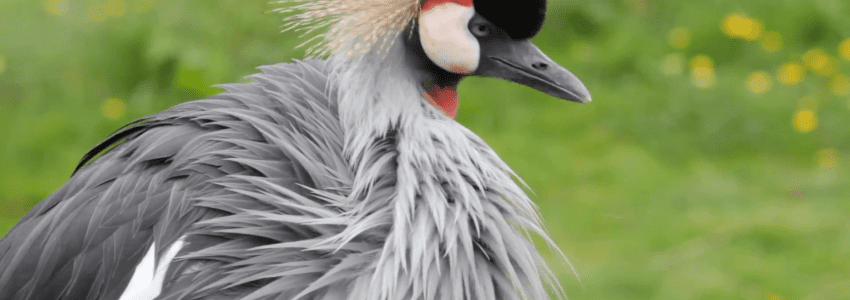The elegant Grey Crowned Crane is the national bird and national symbol of Uganda. It is one of Africa’s most iconic and striking birds, named due to its crown of yellow feathers, tipped with black. This crowned crane moves gracefully with a dignified gait and is beautiful to see in flight with the slow downstrokes followed by quick upward strokes of its wings.
According to the IUCN Red List, the total grey crowned crane population size is around 17,700 – 22,300 mature individuals.
Sadly, populations of these crowned cranes are declining, due to:
- habitat degradation by human development
- changes as a result of drought and climate change
- loss of breeding areas from overgrazing
- drainage of wetlands
- the pet trade
- egg collecting
- use of pesticides (which also kill insects that the bird would normally eat)
- hunting.
Grey crowned cranes are currently classified as Endangered (EN).
What do grey crowned cranes eat?
Grey crowned cranes are omnivores. They eat grain, seeds and plants as well as frogs, worms, snakes, small fish and the eggs of aquatic animals. Grey crowned cranes spend the majority of their day looking for food, and they’ve developed some clever strategies to get it:
- They stamp their feet as they walk to flush out insects, which they’ll quickly catch and eat.
- They also associate themselves with grazing herbivores, grabbing their prey when it’s disturbed by antelopes or livestock.
What makes the grey crowned crane so special?
They like to dance!
During the breeding season, grey crowned cranes perform fascinating dancing displays – they bow, run, dance and jump. They will lower their head to shoulder level, then make low booming calls that inflate their gular sacs. The calls are made while their head is lowered to shoulder level.
It’s the national bird of Uganda
As Uganda’s national bird, the grey crowned crane is featured on the country’s coat of arms and flag. It is also a sacred symbol in Namibia, Kenya, Zambia and South Africa. Many cultures believe that the grey crowned cranes bring rain, so they will include pictures of these cranes in rituals encouraging the rainy season to come.
3 Fun facts about the grey crowned crane
- Unlike other species of cranes, crowned cranes usually roost in trees,
- You may see them flocking in large numbers of between 30 and 150 birds, and
- The chicks are ‘precocial’ – this means they can run as soon as they hatch.
Breeding habits
In Tanzania, Kenya and Uganda, grey crowned cranes breed year-round, but most frequently during the drier periods. These cranes pair up and mate for life. During the breeding season, a pair of cranes construct a large nest by creating a platform of grass and other plants in tall wetland vegetation. The female lays a clutch of 2-5 eggs. The eggs are incubated by both sexes for 28 – 31 days.
See the grey crowned crane in its natural habitat
Find out more and book your tour with us to see this iconic African bird – and many others! – for yourself: https://www.tanzaniabirding.com/contactus.html.

